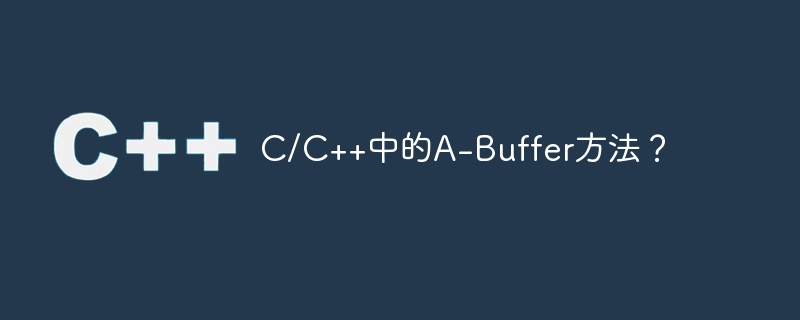A-Buffer method in C/C++?

In computer graphics, A-Buffer technology is a simple hidden surface detection mechanism for medium-sized virtual memory computers. This technique is also known as anti-aliasing, area averaging, or accumulation buffering. This technology extends the algorithm of the depth buffer (or Z-buffer) technology. Since depth buffer technology can only be used for opaque objects and not for transparent objects, A-buffer technology provides advantages in this case. Although A-buffer technology requires more memory, different surface colors can be combined correctly. As a descendant of the Z-buffer algorithm, each position in the buffer can locate or reference a linked list of surfaces.
In the A-buffer, key data structures are treated as accumulation buffers.Each position in the A buffer contains 2 fields −
Intensity field or surface data field
Depth Field
The depth field stores a negative or positive real number. The surface data field can store a pointer to a linked list of surfaces that contributes to that pixel position or surface intensity information.
If the value of depth is >= 0, the number stored at that location is the depth of a single surface that overlaps the corresponding pixel area. The second field, the intensity field, then stores the RGB component of the surface color at that point and the pixel coverage percentage.
With depth
A-buffer technology is slightly more expensive than Z-buffer technology because it requires more memory. Here, depth and opacity are implemented to determine the final color of the pixel.
The surface buffer in the A buffer method includes −
surface identifier
depth
Percent area coverage
Opacity parameter
Pointer to next surface
RGB Intensity Component
Another advantage of A-buffer technology is that it provides anti-aliasing effects in addition to the functions performed by the Z-buffer.
The above is the detailed content of A-Buffer method in C/C++?. For more information, please follow other related articles on the PHP Chinese website!

Hot AI Tools

Undresser.AI Undress
AI-powered app for creating realistic nude photos

AI Clothes Remover
Online AI tool for removing clothes from photos.

Undress AI Tool
Undress images for free

Clothoff.io
AI clothes remover

AI Hentai Generator
Generate AI Hentai for free.

Hot Article

Hot Tools

Notepad++7.3.1
Easy-to-use and free code editor

SublimeText3 Chinese version
Chinese version, very easy to use

Zend Studio 13.0.1
Powerful PHP integrated development environment

Dreamweaver CS6
Visual web development tools

SublimeText3 Mac version
God-level code editing software (SublimeText3)

Hot Topics
 Gulc: C library built from scratch
Mar 03, 2025 pm 05:46 PM
Gulc: C library built from scratch
Mar 03, 2025 pm 05:46 PM
Gulc is a high-performance C library prioritizing minimal overhead, aggressive inlining, and compiler optimization. Ideal for performance-critical applications like high-frequency trading and embedded systems, its design emphasizes simplicity, modul
 What are the types of values returned by c language functions? What determines the return value?
Mar 03, 2025 pm 05:52 PM
What are the types of values returned by c language functions? What determines the return value?
Mar 03, 2025 pm 05:52 PM
This article details C function return types, encompassing basic (int, float, char, etc.), derived (arrays, pointers, structs), and void types. The compiler determines the return type via the function declaration and the return statement, enforcing
 What are the definitions and calling rules of c language functions and what are the
Mar 03, 2025 pm 05:53 PM
What are the definitions and calling rules of c language functions and what are the
Mar 03, 2025 pm 05:53 PM
This article explains C function declaration vs. definition, argument passing (by value and by pointer), return values, and common pitfalls like memory leaks and type mismatches. It emphasizes the importance of declarations for modularity and provi
 C language function format letter case conversion steps
Mar 03, 2025 pm 05:53 PM
C language function format letter case conversion steps
Mar 03, 2025 pm 05:53 PM
This article details C functions for string case conversion. It explains using toupper() and tolower() from ctype.h, iterating through strings, and handling null terminators. Common pitfalls like forgetting ctype.h and modifying string literals are
 Where is the return value of the c language function stored in memory?
Mar 03, 2025 pm 05:51 PM
Where is the return value of the c language function stored in memory?
Mar 03, 2025 pm 05:51 PM
This article examines C function return value storage. Small return values are typically stored in registers for speed; larger values may use pointers to memory (stack or heap), impacting lifetime and requiring manual memory management. Directly acc
 distinct usage and phrase sharing
Mar 03, 2025 pm 05:51 PM
distinct usage and phrase sharing
Mar 03, 2025 pm 05:51 PM
This article analyzes the multifaceted uses of the adjective "distinct," exploring its grammatical functions, common phrases (e.g., "distinct from," "distinctly different"), and nuanced application in formal vs. informal
 How does the C Standard Template Library (STL) work?
Mar 12, 2025 pm 04:50 PM
How does the C Standard Template Library (STL) work?
Mar 12, 2025 pm 04:50 PM
This article explains the C Standard Template Library (STL), focusing on its core components: containers, iterators, algorithms, and functors. It details how these interact to enable generic programming, improving code efficiency and readability t
 How do I use algorithms from the STL (sort, find, transform, etc.) efficiently?
Mar 12, 2025 pm 04:52 PM
How do I use algorithms from the STL (sort, find, transform, etc.) efficiently?
Mar 12, 2025 pm 04:52 PM
This article details efficient STL algorithm usage in C . It emphasizes data structure choice (vectors vs. lists), algorithm complexity analysis (e.g., std::sort vs. std::partial_sort), iterator usage, and parallel execution. Common pitfalls like






